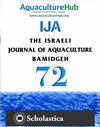Growth performance of Mediterranean Sea species under high temperatures
IF 0.5
4区 农林科学
Q4 FISHERIES
引用次数: 0
Abstract
Diversifying aquaculture in Saudi Arabia with the inclusion of finfish species already reared in the Mediterranean Sea requires a sufficient understanding of the preferences and limits of cultured fish under local conditions. This study was conducted using three finfish species, juveniles (135–155g), meager (Argyrosomus regius), European seabass (Dicentrarchus labrax), and greater amberjack (Seriola dumerili), to assess their growth performance under high temperatures for three-month-long thermal trials. Each species trial was performed in triplicates in a recirculating aquaculture system, while three temperature ranges, 24°C–25°C, 28°C–29°C, and 33°C–34°C, were tested, representing the average temperatures in the Mediterranean and Red Seas. Both meager and European seabass performed similarly between the first two temperatures, indicating that the optimum range lies within that thermal window. Growth performance indicates that it is lower for meager than it is for European seabass. The greater amberjack’s growth performance was similar for the first two temperatures. The temperature of tolerance was 33°C for all species. The species appeared to have similar thermal tolerance with notable differences in the preferable temperature for optimum performance. The findings of this study can be used to improve the growth performance and feed efficiency of Mediterranean species farming in temperature ranges ranging from 24°C–28°C.地中海物种在高温下的生长性能
要使沙特阿拉伯的水产养殖多样化,包括已经在地中海养殖的鱼类,就需要充分了解当地条件下养殖鱼类的偏好和限制。本研究以幼鱼(135 - 155克)、海鲈(Argyrosomus regius)、欧洲鲈鱼(Dicentrarchus labrax)和大琥珀鱼(Seriola dumerili)三种鱼类为研究对象,进行了为期三个月的高温生长试验。每个物种试验在循环水养殖系统中进行三次,同时测试了24°C - 25°C、28°C - 29°C和33°C - 34°C三个温度范围,代表了地中海和红海的平均温度。贫鲈鱼和欧洲鲈鱼在前两个温度之间的表现相似,表明最佳范围在该热窗内。生长性能表明,贫鲈的生长性能低于欧洲鲈鱼。大琥珀在前两个温度下的生长表现相似。所有品种的耐受性温度均为33℃。两种植物具有相似的耐热性,但在最佳生长温度上存在显著差异。本研究结果可用于在24°C - 28°C的温度范围内提高地中海物种的生长性能和饲料效率。
本文章由计算机程序翻译,如有差异,请以英文原文为准。
求助全文
约1分钟内获得全文
求助全文
来源期刊
CiteScore
0.90
自引率
16.70%
发文量
49
审稿时长
3 months
期刊介绍:
Information not localized

 求助内容:
求助内容: 应助结果提醒方式:
应助结果提醒方式:


